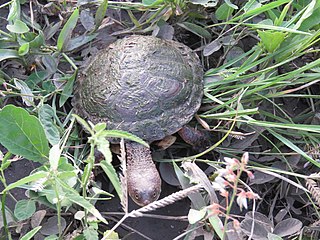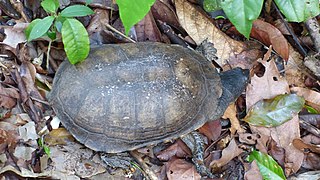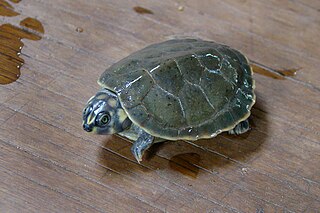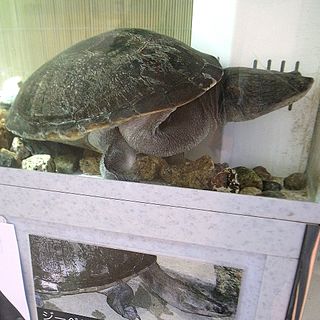
Macrochelys is a genus of very large freshwater turtles in the family Chelydridae, native to the Southeastern and Midwestern United States. Only a single extant species was recognized until 2014, when a study divided it into two, or possibly three species. These turtles are easily recognized by three distinct dorsal ridges with raised spikes.

The northern spiny softshell turtle is a subspecies of soft-shelled turtle in the family Trionychidae. The subspecies is native to the United States and can be found from Montana at the western edge of its range to Vermont and Quebec on the eastern edge. Introduced populations have also been found in Massachusetts, New Jersey, Arizona, and Virginia.

Nilssonia is a genus of softshell turtles from rivers, streams, ponds, and lakes in South Asia and Burma. In many treatments, it is monotypic, with the single species Burmese peacock softshell. However, the supposed other genus of peacock softshells, Aspideretes, is more closely related to N. formosa than had been believed. They differ only in the neural plates between the first pleural scale pair of the bony carapace, which are fused into one in N. formosa and unfused in the others.

The Chaco side-necked turtle is a species of turtle in the family Chelidae. It is found in Argentina, Paraguay, and possibly Bolivia. Its natural habitat is subtropical or tropical moist montane forests. The turtle possesses long horny spurs on its upper thighs. It is 18 cm in shell length. Like other members of its genus, the turtle buries itself in the mud when the streams run dry, a behaviour possibly parallel to the winter hibernating behaviours of turtles further north.

The Brazilian radiolated swamp turtle is a species of turtle in the Chelidae family endemic to Brazil.

The black spine-neck swamp turtle, also commonly known as the spiny-neck turtle or Spix's sideneck turtle, is a species of turtle in the family Chelidae. The species is endemic to South America, specially in the Southern Cone region.

Parker's snake-necked turtle is a species of turtle in the family Chelidae.
Pritchard's snake-necked turtle is a species of turtles in the family Chelidae. The species is endemic to a restricted area of Central Province, Papua New Guinea.
Reimann's snake-necked turtle is a species of turtle in the family Chelidae. The species is endemic to Oceania and Southeast Asia.

The Western New Guinea stream turtle or New Guinea snapping turtle is a species of freshwater turtle in the Chelidae family. It is found in the Bird's Head Peninsula and the Bomberai Peninsula west of Cenderawasih Bay, and on the island of Waigeo of West Papua, Indonesia.
The Sulawesi forest turtle is a critically endangered species of turtle in the family Geoemydidae. The species is monotypic within the genus Leucocephalon. It is endemic to Sulawesi in Indonesia.

The six-tubercled Amazon River turtle or six-tubercled river turtle is a species of turtle in the family Podocnemididae.

Chelodina (Chelydera) burrungandjii, the sandstone snake-necked turtle or Arnhem Land long-necked turtle, is a medium-sized turtle reaching carapace lengths of 316 mm. The species is found in the sandstone plateaus and escarpments and the plunge pools of Arnhem Land of the Northern Territory. The species had been long recognised as valid. However, it had been difficult to research due to the remoteness of its habitat. Efforts to breed this species in captivity had been largely unsuccessful, until National Aquarium Herpetologist Matthew Benedict lead a successful breeding project in 2021. The species occurs in proximity to Chelodina rugosa, to which it is closely related. For the most part the two species are parapatric in distribution. However, they do come together in limited locations such as plunge pools at the base of the escarpments. In these areas there is hybridization between the species.

The Myanmar brown leaf turtle is a species of Asian leaf turtle found in Myanmar.

Cyclemys enigmatica, also known as the enigmatic leaf turtle, is a species of Asian leaf turtle. It is found in the Greater Sunda Islands and the Malay Peninsula.

The eastern black-bridged leaf turtle is a species of Asian leaf turtles found in southern Indochina.

Emydura macquarii is a species of turtle in the family Chelidae. It is a wide-ranging species that occurs throughout many of the rivers of the eastern half of Australia. It is found primarily in the Macquarie River basin and all its major tributaries, along with a number of coastal rivers up the New South Wales Coast. It is also found in the coastal Queensland rivers and the Cooper Creek ecosystem, along with Fraser Island.

Elseya schultzei, commonly known as Schultze's snapping turtle, is a species of chelid turtle endemic to northern New Guinea.

Chelodina (Chelydera) kuchlingi, commonly known as Kuchling's long-necked turtle or Kuchling's turtle, is a species of freshwater turtle in the family Chelidae. The species is endemic to Australia.
Chelodina gunaleni, also known commonly as Gunalen's long-necked turtle and Gunalen's snake-necked turtle, is a species of turtle in the family Chelidae. The species is endemic to the lowlands of west-central West Papua, Indonesia, south of the central ranges.



















